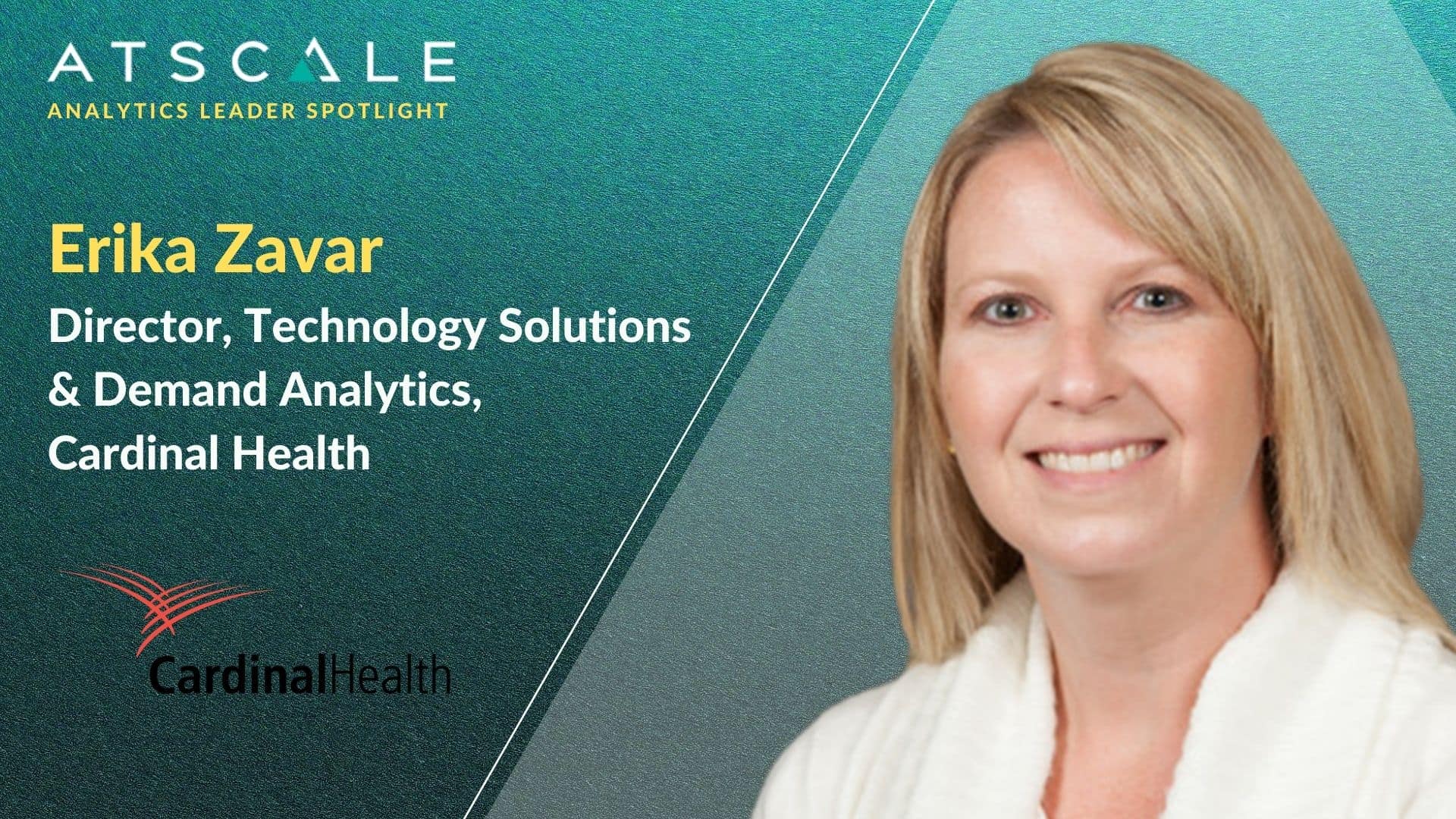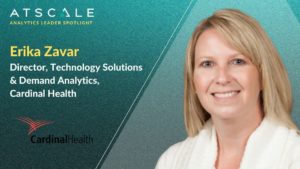

Welcome to our first interview in our new “Analytics Leader Spotlight” series. In this series we’ll be interviewing data and analytics leaders who reflect on how they got started in their career, highlighting the projects that they’re currently working on, and discuss the challenges that they are facing.
In this interview, we’re honored to introduce you to Erika Zavar, Director of Technology Solutions and Demand Analytics at Cardinal Health. Erika has been working for Cardinal Health for 17 years and is a true data analytics champion.
Erika, thank you for taking the time to share your experiences as a data and analytics leader with us. Tell us what your role is at Cardinal Health and can you explain the responsibilities that come with your job?
A: Of course! I am the Director of Technology Solutions and Analytics at Cardinal Health, a 100-year-old healthcare services and products company, providing customized solutions for hospitals, healthcare systems, pharmacies, ambulatory surgery centers, clinical laboratories and physician offices worldwide. I manage a team that sits within supply chain for the pharmaceutical segment. The team is mostly focused on solving business supply chain issues, either by evaluating and making enhancements or changes to the existing technology or by bringing in new technologies.
I also have two analytics teams, one that specifically addresses supply chain issues and another one that focuses on machine learning and automation opportunities. These teams mainly focus their work on network reorganization which means that they are looking at how we can better utilize our external transportation or product flow within our internal network.
Outside of these teams, I also have another group of teams that are strictly focused on data, whether that be in our SAP implementation project or within our Google Cloud Platform. Their goal is to help extract and identify gaps in the technology or the data landscape.
Walk us through your career journey. How did you get started in the analytics field?
A: I came up through finance first. I love math, numbers and solving problems. From finance, I discovered the technology space within supply chain. At the beginning, I was working more on the technology side working with the different technology groups around the organization, mainly within supply chain to create efficiencies and enhancements and implementing new pieces of technology and functionality. After a few years, we found that we had a really good base from a technology standpoint, so my focus then changed to optimization of our technology stack. I began to look at how we at Cardinal Health can identify gaps and opportunities within the technology we work with and how to address the gaps and opportunities that are not necessarily technology related.
In total, I’ve been with Cardinal for 17 years now. Since the beginning there have been various projects that I’ve been involved with. Every seven years or so, it feels like I find a new passion or a new thing that I love to do within Cardinal Health.
So you’re sitting amongst data all day. It sounds like data is your entire life at Cardinal Health.
A: It pretty much is!
In your opinion, do you find that a lot of the data and analytics leaders within Cardinal Health are coming from the business side of the house?
A: I would say that’s not necessarily the standard. The analytics teams at Cardinal Health are embedded with any business function. Several members of the analytics team started out as transportation coordinators or operations managers. They were utilizing analytics to solve problems within their area at Cardinal Health and learned that they had a passion for analytics.
Let me explain further, because within each business function at Cardinal Health, there is essentially an analytics team. Pricing has their own analytics team. Finance has their own team. Transportation and operations have their own analytics teams. And the supply chain has their own analytics team. From a data perspective, many of our leaders have come up through enterprise architecture or IT or more governance organizations rather than being embedded within a business unit.
When you look at your role today, what would you say are the top challenges that you’re trying to overcome?
A: Two big challenges for me are staying on top of the pace of technology and getting people to understand the value of data. The pace is very fast, meaning that there are a lot of new technologies coming out everyday. That leads to a technology schizophrenia which if not monitored can cause us to lose sight of the projects that we’ve started.
We’ve also seen a lot of people using the terms “use case” and “business problems” casually which doesn’t necessarily lead to a holistic data strategy. Getting people to move out of departmental silos of data and understand the value of making that information available to others is key to improving business intelligence and outcomes. I would say that right now those are the two things that challenge me the most.
Would you explain how you measure the metrics of success for a particular project?
A: Within supply chain, metrics for success are easy. Projects and initiatives are directly related to supply chain dollars. From that perspective it’s inventory dollars. For example, we carry $100’s of millions in inventory, so 1% improvement has a big impact on the bottom line.
When I’m looking at true big data initiatives, the metrics for success are about action and usage so I’m looking to particular groups to understand the value that they’re deriving with data. It can be a little challenging at times because adoption can be slow. The word “evangelize” has become a part of a lot of business terminologies when it comes to different initiatives because someone needs to be the advocate for particular projects and be able to explain the team’s higher goal.
In your 17 years of working at Cardinal Health, do you have a project or initiative that you’re particularly proud of?
A: There are a few, actually. I would say one of the initiatives that I’m most proud of is the last round of SAP implementation within our supply chain functions which had very little interruptions to the business. There were no hiccups in the actual replenishment purchasing patterns. It was pretty much seamless to the suppliers and the business when we inserted SAP into our process.
Another initiative that I’m proud of is the most recent upgrade within supply chain in our actual replenishment system. This had zero impact on the business, meaning that there were no errors or no purchase orders that were made incorrectly or that were for the wrong amount. There were only five defects across the entire climate which was pretty good.
In the data space, I would say our AtScale initiative is another one that I’m proud of. I saw the value AtScale would provide to our business and was able to evangelize the solution and get all of our stakeholders on board. I’ll be even prouder of it when we drive user adoption across our business because of the value AtScale will bring to our analytics and artificial intelligence projects.
What piece of advice would you offer to others who are just building their careers in the data and analytics space?
A: That’s a good question. I would say that if you’re starting your career in data and analytics and you don’t have any business area or function background, being able to effectively communicate and partner with the business unit is going to be critical to your success. Any mathematician can write a machine learning model or can write code for a business problem. But if you can’t understand and partner with those business users to understand the business context and the problem that they’re trying to solve, you’re going to really struggle to deliver a solution that really solves a business problem. I suggest that upcoming data and analytics professionals work on communication and listening skills. It’s okay to go through many iterations with a particular partner to make sure that you get it right as long as you’re communicating with the business.


SHARE
Guide: How to Choose a Semantic Layer